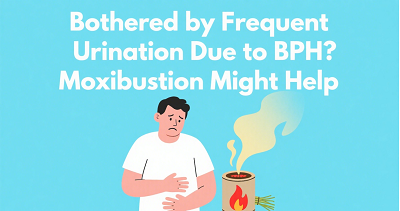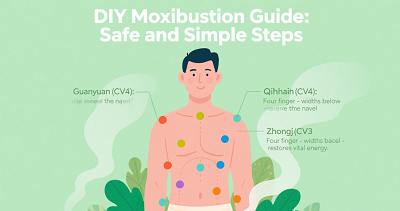Bothered by Frequent Urination Due to BPH? Moxibustion Might Help
Benign prostatic hyperplasia (BPH) can be more than just a minor inconvenience. Many middle-aged and older men struggle with frequent urination, urgency, weak urine flow, and the constant feeling of incomplete emptying. These symptoms can silently reduce quality of life and affect daily comfort.

Fortunately, Traditional Chinese Medicine (TCM) offers gentle and holistic methods to support prostate health. One such approach is moxibustion, which uses heat therapy on specific acupuncture points to tonify kidney yang and promote the circulation of qi and blood. This ancient method may offer relief from urinary symptoms when practiced correctly.
Why Does the Prostate Become Enlarged?
Prostate enlargement is not random. Several contributing factors include:
- Hormonal changes: With age, levels of androgens—particularly dihydrotestosterone (DHT)—fluctuate, stimulating abnormal growth in prostate tissue.
- Chronic inflammation: Long-standing inflammation in the prostate may exacerbate hyperplasia.
- Lifestyle and metabolic issues: Vitamin D deficiency, obesity, and high blood sugar levels are also associated with BPH.
As the enlarged prostate compresses the urethra, it’s like a kinked hose—urine flow weakens, the bladder struggles to empty fully, and this leads to frequent urges, urgency, and dribbling.
The Warming Magic of Moxibustion
How exactly can moxibustion help?
- Improves local blood flow: The gentle heat penetrates tissues, enhancing circulation around the prostate and helping reduce congestion and swelling.
- Relaxes pelvic floor muscles: The warm stimulation can ease muscle tension and support smoother urination by modulating related nerves.
- Restores kidney yang and qi flow: In TCM, BPH is often linked to kidney yang deficiency or qi and blood stagnation. Moxibustion helps ignite internal warmth, unblocking meridians and revitalizing the lower abdominal region.
DIY Moxibustion Guide: Safe and Simple Steps
Key acupuncture points to focus on:
- Guanyuan (CV4): Four finger-widths below the navel – restores vital energy.
- Qihai (CV6): About two finger-widths above Guanyuan – strengthens kidney qi.
- Zhongji (CV3): Just above the pubic bone – near the bladder area.
- Shenshu (BL23): On the lower back, near the second lumbar vertebra – boosts kidney yang.
- Sanyinjiao (SP6): Four finger-widths above the inner ankle – regulates the liver, spleen, and kidney.
How to do it:
1. Choose a warm, draft-free environment.
2. Use a quality moxa stick or moxibustion box.
3. Lie down for abdominal points; use the prone position or ask for help for lower back points.
4. Hold the moxa stick 2–3 cm above the skin, rotating gently until you feel warm but not burning.
5. Do it every other day for 10 sessions as a trial period.
6. Important: Avoid burns. Those with reduced sensation (e.g., diabetics) must monitor skin closely.
Aftercare matters: Keep the body warm, avoid cold exposure or contact with water for at least two hours post-session.
Avoid moxibustion if you have:
- Fever, acute urinary tract infection, or acute prostatitis
- Hematuria (blood in urine) or severe pain
- Suspected or confirmed prostate cancer
- Skin infections, open wounds, or bleeding disorders
Some individuals may notice increased urinary frequency in the early stages of treatment. This usually stabilizes with continued sessions. However, if symptoms worsen, stop the therapy and consult a professional.

How Effective Is Moxibustion?
Many users report positive results—especially those with mild to moderate BPH symptoms. Moxibustion seems to help more for individuals with a cold-deficiency constitution—those who are often tired, feel cold easily, or have cold limbs.
However, moxibustion is not a cure for prostate enlargement. It’s a supportive therapy. The overgrown tissue will not shrink solely through moxa. For moderate to severe urinary retention, medications are necessary.
Effective Herbal Support: Diuretic and Anti-inflammatory Pill
If you are looking for natural alternatives to support your prostate health, the Diuretic and Anti-inflammatory Pill, developed with traditional Chinese medicine principles, may be a beneficial choice. It helps:
- Alleviate frequent urination, urgency, and incomplete emptying
- Resist further hyperplasia and fibrosis
- Promote blood circulation and clear inflammation
This herbal formulation has been especially helpful for patients with BPH, chronic prostatitis, and prostatic calcification.
Who Should Try Moxibustion?
Recommended for:
- Men with early-stage or mild BPH symptoms
- Individuals with weak or cold constitutions
Not recommended for:
- Those with acute infections, fever, or severe urinary obstruction
- Patients diagnosed or suspected of having prostate cancer
- Individuals with numbness at the site, open wounds, or bleeding risks
Combine Therapies for Better Results
Moxibustion works best when combined with other strategies:
Medication:
- Diuretic and Anti-inflammatory Pill – addresses symptoms and underlying inflammation naturally
- Finasteride or Dutasteride – clinically prescribed to inhibit prostate growth
Lifestyle changes:
- Avoid caffeine, alcohol, and spicy foods
- Limit fluids before bedtime
- Don't delay urination and take regular breaks from sitting
- Practice good hygiene and wear breathable cotton underwear
Additional techniques:
- Kegel exercises: Strengthen pelvic muscles to improve bladder control
- Warm sitz baths: Soothing the pelvic region before sleep helps ease muscle tension
Final Thoughts
Moxibustion is a time-honored therapy that brings gentle warmth to support prostate health—especially for those struggling with mild urinary issues due to BPH. Still, it should be seen as a complementary option, not a replacement for proper diagnosis and medical treatment. For the best outcome, combine herbal remedies like the Diuretic and Anti-inflammatory Pill, doctor-recommended medications, and healthy daily habits.
Early awareness and timely action are key. Don't ignore the signs—take control and create a proactive prostate care routine today.



